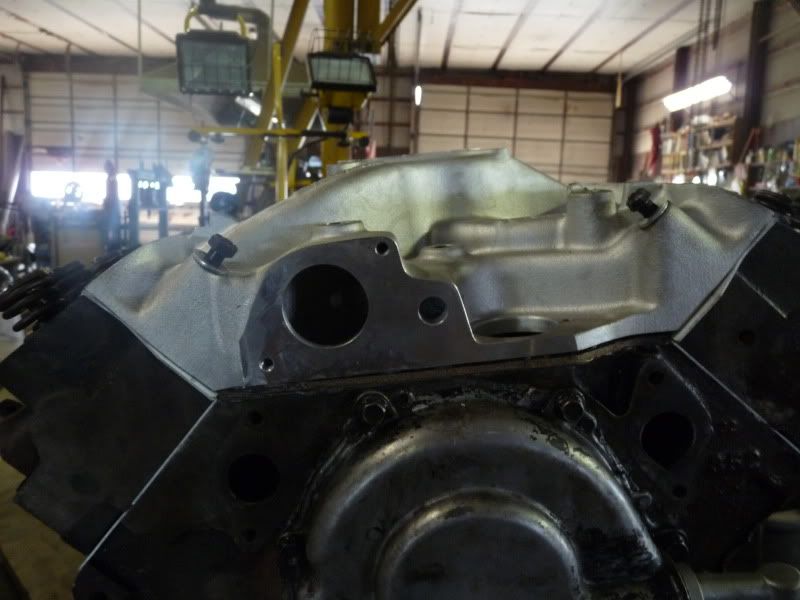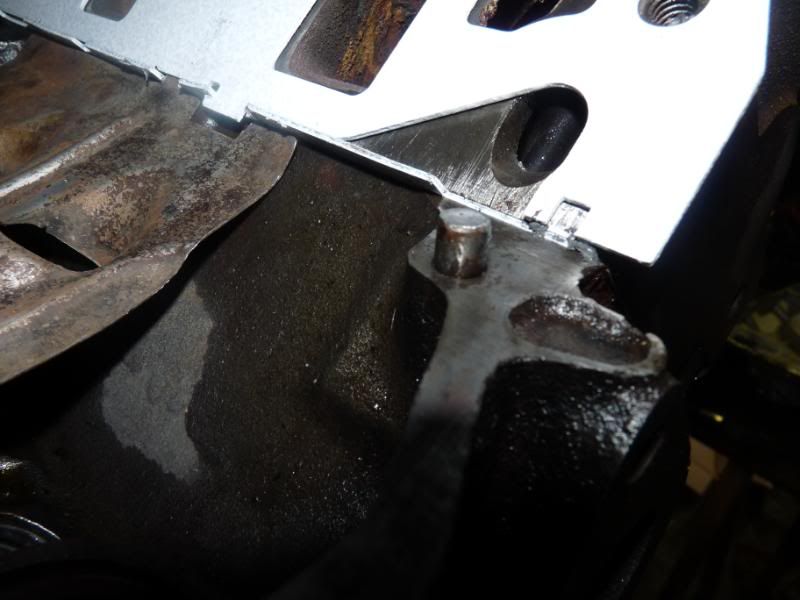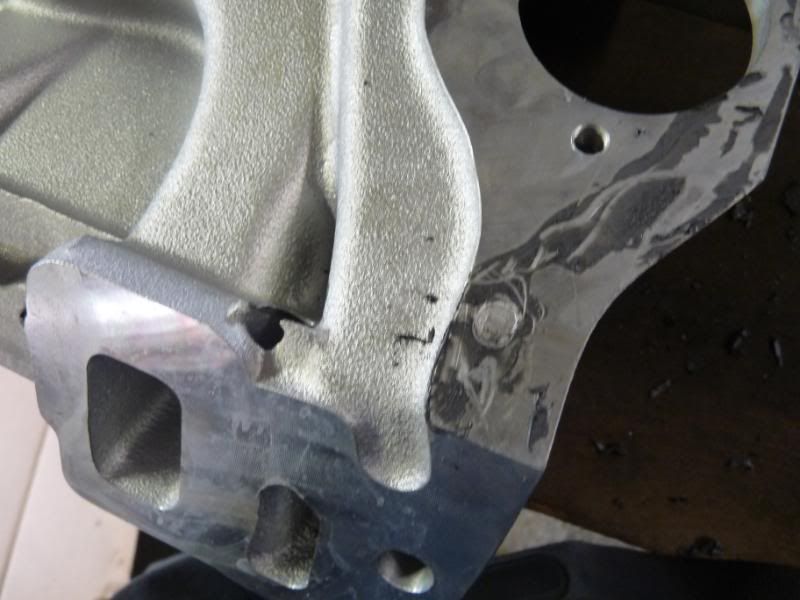HUGE GAP BETWEEN INTAKE MANIFOLD AND HEADS
#1
HUGE GAP BETWEEN INTAKE MANIFOLD AND HEADS
I have a 1969 390 block that I just had rebuilt by a very reputable engine rebuilder in SoCal(Wayne's Engine Rebuilders). The block came out of my 1954 Ford Customline, it has been in there since the 1970s. I recently began restoring the entire car and drivetrain and decided to add a little extra performance. I had the longblock completely rebuilt keeping the heads that were originally mated with the engine. I had an RV cam installed and told the rebuilder that I wanted an edelbrock performer 390 aluminum intake manifold. They told me no problem and that they would install it on the engine for me, which they did. When I got the engine back and began the process of prepping it for the drop in I noticed as well as my friends that there was a significantly large gap on the front driver's side of the block between the intake manifold and the head(where the intake rests on the head). We began some investigating and discovered based on the casting numbers of the block and heads that the engine was a 1969 390, but the heads were for a 1968 427. We didn't know if this was a compatible match or not, but we assumed that since the engine builder never mentioned that it was going to be a problem that it should work and not cause any problems. Our concern was the gap between the intake and heads, but we took a risk and dropped in the motor and when we fired it up for the first time it hydrolocked(not under power though). We pulled the NO.1 Plug and discovered water. Now I have to go through the process of trying to get them to explain why this gap was there and what they are gonna do to fix the problem.
Basically my question to any of you is, do you think that the the 390 block and 427 heads are a problem together or is the problem the fact that the 390 intake manifold and 427 heads are a problem together? Or is it something else entirely, if they are all compatible with each other is it perhaps maybe that something is warped?
Any feedback or input is greatly welcomed!
Basically my question to any of you is, do you think that the the 390 block and 427 heads are a problem together or is the problem the fact that the 390 intake manifold and 427 heads are a problem together? Or is it something else entirely, if they are all compatible with each other is it perhaps maybe that something is warped?
Any feedback or input is greatly welcomed!
#2
Welcome to FTE.
Sounds like someone cut on the heads and not the intake, thus creating a large gap that the gasket could not fill. First thing: Did they use the CORK end rail gaskets? These can be TOO thick and raise the intake up and not allow it to touch the heads. Usually when mocking up the intake you leave those cork end gaskets out and see what the gap is just using the side gaskets. Most of my FE's only have silicone for end seals as the cork is too thick.
If the heads have been cut, thus lowering them to the block, the intake will need cut(sides and ends) to allow it to drop down farther to meet heads.
Sounds like your builder needs a lesson in intake installation(or maybe just a set of better glasses). I hope it didn't hurt anything when it locked up(hope you were just slowly turning it over. It can bend a rod up quick if it tired to fire at all.
Sounds like someone cut on the heads and not the intake, thus creating a large gap that the gasket could not fill. First thing: Did they use the CORK end rail gaskets? These can be TOO thick and raise the intake up and not allow it to touch the heads. Usually when mocking up the intake you leave those cork end gaskets out and see what the gap is just using the side gaskets. Most of my FE's only have silicone for end seals as the cork is too thick.
If the heads have been cut, thus lowering them to the block, the intake will need cut(sides and ends) to allow it to drop down farther to meet heads.
Sounds like your builder needs a lesson in intake installation(or maybe just a set of better glasses). I hope it didn't hurt anything when it locked up(hope you were just slowly turning it over. It can bend a rod up quick if it tired to fire at all.
#3
Welcome to FTE.
Sounds like someone cut on the heads and not the intake, thus creating a large gap that the gasket could not fill. First thing: Did they use the CORK end rail gaskets? These can be TOO thick and raise the intake up and not allow it to touch the heads. Usually when mocking up the intake you leave those cork end gaskets out and see what the gap is just using the side gaskets. Most of my FE's only have silicone for end seals as the cork is too thick.
If the heads have been cut, thus lowering them to the block, the intake will need cut(sides and ends) to allow it to drop down farther to meet heads.
Sounds like your builder needs a lesson in intake installation(or maybe just a set of better glasses). I hope it didn't hurt anything when it locked up(hope you were just slowly turning it over. It can bend a rod up quick if it tired to fire at all.
Sounds like someone cut on the heads and not the intake, thus creating a large gap that the gasket could not fill. First thing: Did they use the CORK end rail gaskets? These can be TOO thick and raise the intake up and not allow it to touch the heads. Usually when mocking up the intake you leave those cork end gaskets out and see what the gap is just using the side gaskets. Most of my FE's only have silicone for end seals as the cork is too thick.
If the heads have been cut, thus lowering them to the block, the intake will need cut(sides and ends) to allow it to drop down farther to meet heads.
Sounds like your builder needs a lesson in intake installation(or maybe just a set of better glasses). I hope it didn't hurt anything when it locked up(hope you were just slowly turning it over. It can bend a rod up quick if it tired to fire at all.
#5
Sounds like your "builder" may be a Chebbie type guy- they tend to booger up FE's when given the chance. Perhaps some pretty heavy cuts on the decks and/or heads, probably unnecessary, maybe the thick end gaskets- you can see if there's a gasket or silicone, look between the intake and block, up in front of the distributor, and above the water pump. As Barry said, it may have the pin in the front flange, by the distributor.
What led you to believe that the heads are '68 427 castings? If they are, they would have had some value in unmolested condition, but if someone has hacked them up and milled them excessively... What are the casting #s and date codes of the heads?
What led you to believe that the heads are '68 427 castings? If they are, they would have had some value in unmolested condition, but if someone has hacked them up and milled them excessively... What are the casting #s and date codes of the heads?
#6
Thank you so much for this information, I have a very strong feeling that this is exactly what the cause of the problem may be, I have notified the engine rebuilder and instructed them to investigate this and see if this is the cause. It would make perfect sense that it is seeing as how the gap is located on the front driver's side of engine between the intake and the block, which is also near the distributor. I don't know how they could have missed something like that, WOW! But thanks again so much for the information.
#7
Sounds like your "builder" may be a Chebbie type guy- they tend to booger up FE's when given the chance. Perhaps some pretty heavy cuts on the decks and/or heads, probably unnecessary, maybe the thick end gaskets- you can see if there's a gasket or silicone, look between the intake and block, up in front of the distributor, and above the water pump. As Barry said, it may have the pin in the front flange, by the distributor.
What led you to believe that the heads are '68 427 castings? If they are, they would have had some value in unmolested condition, but if someone has hacked them up and milled them excessively... What are the casting #s and date codes of the heads?
What led you to believe that the heads are '68 427 castings? If they are, they would have had some value in unmolested condition, but if someone has hacked them up and milled them excessively... What are the casting #s and date codes of the heads?
Trending Topics
#8
DIF just means Dearborn Iron Foundry, where the early blocks were cast.
C8AE is just the prefix of the casting #, you need the whole thing, and the date codes- the only '68 car with a 427 installed was the Cougar GTE, and a genuine set of heads with the correct #'s would have some value- enough that you wouldn't want to use them on a pickup engine, you'd want to sell them to finance the rest of your engine, like maybe a new set of E-bocks- plus. Also, count the number of exhaust bolt holes- should be 8, 14, or 16
C8AE is just the prefix of the casting #, you need the whole thing, and the date codes- the only '68 car with a 427 installed was the Cougar GTE, and a genuine set of heads with the correct #'s would have some value- enough that you wouldn't want to use them on a pickup engine, you'd want to sell them to finance the rest of your engine, like maybe a new set of E-bocks- plus. Also, count the number of exhaust bolt holes- should be 8, 14, or 16
#9
Ok, I will look into this further, can you recommend a website where I can look up the casting numbers and get the correct information. Also, can you specify where on the heads I should look for the true casting numbers and date codes and give me an example of what I am looking for. I would greatly appreciate it. You've got my curiosity peaked now! Thanks again...is it possible that they are 390 heads? Would a 1969 390 block have come with 1968 heads? And I think that the engine is not from a pickup because I believe it reads C9AE on the block, or does this make a difference?
#10
#11
#12
#13
You're confusing the casting #'s with dates- the C8 and C9 are the year that the part went into service- if a casting was revised, it got a new casting number reflecting the change. If a part never got changed, it would still have it's original numbers- some of the old standard oil pumps & such had early '60's numbers for many years, as there were no changes made. The C8AE-6090-J heads were used on some very early CJ's and then on the gelded 427's in the early Cougar GTE's, and the later GTE's got regular production 428 CJ's. IIRC, the -J heads also had the 14 bolt exhaust pattern like a 390GT head, while the regular production 428 CJ head C8OE-6090-N had the 16-bolt pattern. Also note the "O" instead of an "A" in the prefix, denoting that the part was originally intended for the Fairlane family (O) instead of Galaxie/ general Ford (A). Both heads are basically just the old 427 low-riser head with a few minor changes- like tabs added to accommodate the extra exhaust holes, and they were generally not machined for the steel valve spring seats used on the early low-risers
#14
There is a dowel pin in the block on the driver side that has to be removed. There isn't a hole cast in the intake for it and if it was torqed down, sure enough there will be a nasty gouge in the intake. Is this what it looks like sititng on there.

Here is the dowel Pin, I couldn't pull it out so I cut it off.

This is what it did the the intake.

I was also told that the heads may have been milled, the intake not cast right, so I pulled it apart and found the dowl pin, I cut it off and put the intake back on using the correct edelbrock gaskets using gasgacinch and DO NOT use the cork end seals, they keep the head sides of the intake from sealing, so just use a good thick bead of RTV. Thats what I did and it I haven't had any problems yet.

Here is the dowel Pin, I couldn't pull it out so I cut it off.

This is what it did the the intake.

I was also told that the heads may have been milled, the intake not cast right, so I pulled it apart and found the dowl pin, I cut it off and put the intake back on using the correct edelbrock gaskets using gasgacinch and DO NOT use the cork end seals, they keep the head sides of the intake from sealing, so just use a good thick bead of RTV. Thats what I did and it I haven't had any problems yet.
#15
There is a formula that engine builders and machine shops are supposed to use when machining blocks, heads and manifolds for the Ford FE/FT engines. Unfortunately a lot of machine shops rarely see the FE engines often enough to be on top of it and a lot of todays machinests are younger than the engines they are working on so they just don't have enough experience with that particular engine. At one time Ford produced thin end rail cork gaskets for just such variables. Now the RTV is the way to go.
If you need the milling formula send me a PM and I'll dig it up an make a post of it.
And, If those are really '68 427 heads they are worth a bunch as they are really rare. Over the years I've had more than a hundred 427s and only found 1 set of the '68 427 390hp engine heads. Don't waste them on a truck.
If you need the milling formula send me a PM and I'll dig it up an make a post of it.
And, If those are really '68 427 heads they are worth a bunch as they are really rare. Over the years I've had more than a hundred 427s and only found 1 set of the '68 427 390hp engine heads. Don't waste them on a truck.


